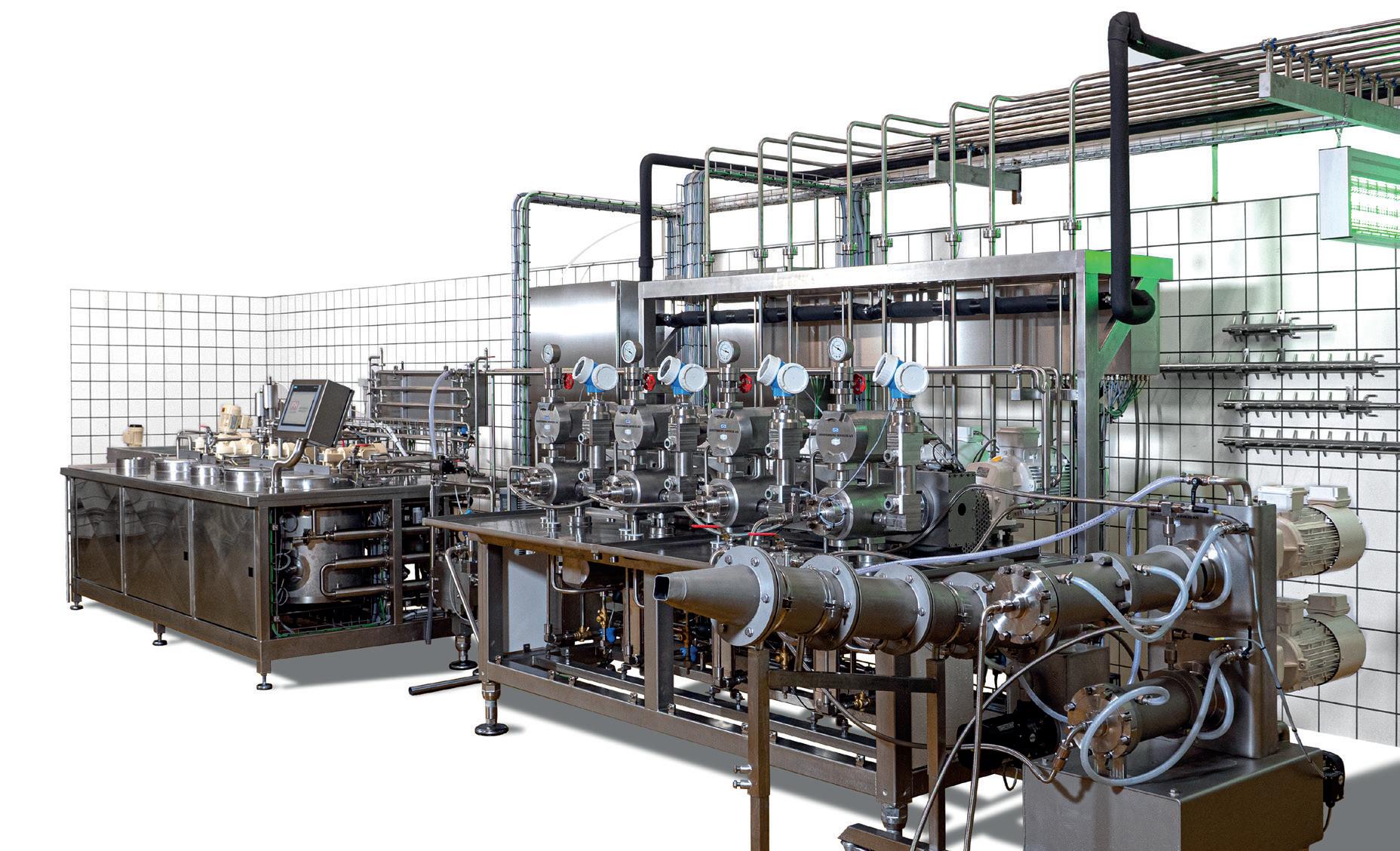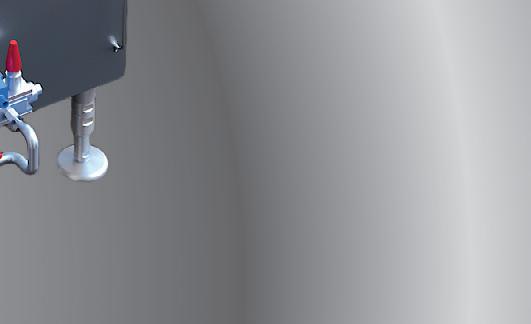
13 minute read
Butter’s rival
e global margarine market has developed to include lowfat and low-salt spreads and products with added omega-3 fatty acids, plant sterols and certi ed oils, with a growing appeal to vegans searching for an alternative to butter OFI
The global margarine/spread market is expected to grow with a single digit increase in CAGR between 2018 and 2028, according to a recent report by Persistence Market Research (PMR).
Growth will be driven by consumer demand for food products high in nutriti onal value and low in fat and calorie content, and higher consumpti on in under-developed countries where margarine off ers greater value for money and multi ple usages.
“The global market for margarine/spread is dominated by North America, which holds a signifi cant market share, followed by Europe and Asia-Pacifi c,” PMR says.
“North America is the largest consumer, especially due to the high consumpti on in food processing. Europe is the second largest consumer. Developing regions, such as Asia-Pacifi c and South America, are constantly growing at a high consumpti on rate. China and India are the largest producers and consumers of margarine/ spreads in the Asia-Pacifi c region.”
PMR says a growing number of vegan customers are also looking for butt er alternati ves, with margarine and spreads off ering a plant-based alternati ve which has less saturated fats and cholesterol.
“Immense competi ti on exists in the global margarine/spread market due to high market concentrati on. Only 18 major companies hold most of the market share.”
Some of the prominent players in the global margarine/spread market are Boulder Brands, Bunge, ConAgra Foods, Dairy Crest, Land O’Lakes, NMGK Group, Smart Balance, Unilever and Upfi eld Foods, PMR says.
Development of margarine
Margarine has a history dati ng back some 150 years and is a non-dairy product used as a fl avouring, for cooking and in baking to produce products such as pastries, doughnuts, cakes and cookies.
It comes as a soft and spreadable spread in tubs, as a liquid cooking blend in bott les and in hard blocks used in baking.
The fi rst margarine was created by
Hippolyte Mège-Mouriès in 1869, who responded to a challenge by Emperor Napoleon III to create a butt er substi tute for the armed forces and lower classes. The recipe was a mix of skimmed milk, water and animal fat.
In 1871, Mège-Mouriès sold his patent to Dutch fi rm Jurgens. Jurgens realised that for the naturally white margarine to become a butt er substi tute, it needed to look like butt er and began dyeing margarine yellow. Jurgens eventually became a world-renowned maker of margarines and soaps, becoming part of consumer goods giant Unilever.
Between 1900 and 1920, commercial oleomargarine was produced from a combinati on of animal fats and hardened and unhardened vegetable oils, according to Wikipedia. The depression of the 1930s and WWII led to a scarcity of butt er and animal fats, leading to an almost complete switch to vegetable oils and fats.
Voluntary forti fi cati on of margarine with vitamins had been carried out by manufacturers since 1925 but in 1940, with the advent of WWII, certain governments made the additi on of vitamins A and D compulsory to safeguard nutriti onal health.
During the 1950s and 1960s, competi ng producers vied to produce margarine that tasted more like butt er.
In the mid-1960s, the introducti on of two lower-fat blends of butt er oil and vegetable oils in Scandinavia, called Lätt & Lagom and Bregott , began the debate on what should be called ‘margarine’ leading to the introducti on of the term ‘spread’, Wikipedia says. In 1978, an 80% fat product called krona, made by churning a blend of dairy cream and vegetable oils, was introduced in Europe and, in 1982, a blend of cream and vegetable oils called Clover was introduced in the UK by the Milk Marketi ng Board. The vegetable oil and cream spread ‘I Can’t Believe It’s Not Butt er!’ was introduced into the USA in 1981 and in Canada and the UK in 1991.
Today, margarine and spreads are typically made from cott onseed, olive, palm, rapeseed, soyabean and sunfl ower oils. The product has gone through many developments to improve its health profi le. Most brands have phased out the use of parti ally hydrogenated oils and are now also trans fat free. Many brands have launched refrigerator margarine spreads that contain only a third of the fat and calorie content of traditi onal spreads.
Other varieti es include those with added omega-3 fatt y acids, those with low or no salt, those with added plant sterols and stanols (claimed to reduce blood cholesterol) and some made from certi fi ed sustainable oils.
Defi nitions
To be classifi ed as margarine, the product must have a vegetable fat content of 80% or more, similar to butt er, Wikipedia says.
Over the years, producers have reduced
The GERSTENBERG Polaron pilot plant sets new standards in the crystallisation of margarine

· State of the art pilot plant · Innovative technology · Available for CO 2 and NH 3 · Flexible · Efficient · Top quality
Gerstenberg Services A/S Copenhagen, Denmark
GERSTENBERGS.COM

u the fat and calorie content of margarines. These lower fat options are officially called ‘spreads’. The EU limits the terms ‘butter’ and ‘margarine’ to products with a fat content of not less than 80%.
It defines spreadable fats as “a waterin-oil emulsion derived from vegetable/ animal fats, with a fat content of at least 10% but less than 90%, that remains solid at a temperature of 20°C and is suitable as spread”.
Margarines may not have a milk fat content of more than 3%. For blends and blended spreads, the milk fat may be between 10% and 80%.
Spreads that contain 60-62% of fat may be called ‘three-quarter-fat margarine’ or ‘reduced-fat margarine’. Spreads that contain 39-41% of fat may be called ‘half-fat margarine’, ‘low-fat margarine’, or ‘light margarine’. Spreads with any other percentage of fat are called ‘fat spread’ or ‘light spread’.
Butter vs margarine
In the past, the popularity of margarine was of great concern to dairy farmers, who lobbied legislators to ban the yellow dyeing of margarine. Bans on adding colour became commonplace in Canada, Denmark and the USA.
By 1900, artificially coloured butter was contraband in 30 US states, Mental Floss writes. Some states even required margarine to be dyed pink. The Canadians banned all margarine from 1886 to 1948, except between 1917 and 1923 when WWI left butter in short supply. Even after the ban was relaxed, Quebec ensured that the ban on dyeing margarine remained in place in the province until 2008.
In Australia, it did not become legal to sell coloured margarine until the 1960s.
The harder spreadability of butter has also helped the growth of the margarine industry.
Many popular table spreads sold today
Gerstenberg introduces new pilot plant
Denmark’s Gerstenberg Services AS has recently introduced a fully automated pilot plant for the crystallisation of all types of fats, margarine and butter products.
The firm is a leading equipment supplier for the production of margarine, puff pastry, shortening, ghee and related products within the yellow fat and edible oil industry.
“The new POLARON plant allows producers of yellow fat products to make test runs in order to determine the optimum processing conditions for their products, either on site or in-house at their production sites,” Gerstenberg says.
The pilot plant comprises a preparation/remelt line and a crystallisation section – a complete industrial production plant in small scale.
Preparation/remelt: A fully automatic emulsion preparation section houses a melting tank and oil storage tank, with fully automatic water phase, emulsifier and emulsion preparation. Gerstenberg says this offers the possibility to run continuous crystallisation, an advantage in the manufacture of products for market tests of a limited volume, which is costly to carry out at a full-scale plant.
The plant also has an automatic remelt function, allowing remelted product to be returned to the emulsion buffer tank while waiting to reach the different product setpoints, minimising product loss.
Crystallisation: The pilot plant’s scraped surface heat exchanger (SSHE) is designed for crystallisation with CO 2 as a refrigerant. However, it can also accommodate customers and markets where ammonia is still used.
“The CO 2 boosts cooling capacity as the volumetric efficiency is up to seven times higher than that of other refrigerants and gives low energy consumption during production and a low carbon footprint,” Gerstenberg says.
The design of the SSHE makes it possible to run with exactly the same tip speed on the rotors as that on an industrial SSHE, allowing an exact upscaling to an industrial plant, the company says.
The rotor is equipped with an advanced scraper system (open hinge) in either plastic with two scraping edges, or steel with four scraping edges, allowing several scraper configurations to be used (staggered etc), which ensures highly efficient scraping of crystallised product from the interior tube surface.
“The pin rotor machine is a stand-alone unit, reflecting a pin rotor machine in an industrial plant,” Gerstenberg says. In addition, the machine has a modular design, allowing the pin rotor cylinder to be mounted in three different places in the process. At the same time, each cylinder can be changed to have three different volumes.
Gerstenberg says the pilot plant is for a working pressure of 120 bar, enabling all product types to be made, and has a semi-automatic clean-in-place (CIP) function. are blends of margarine and butter or other milk products, Wikipedia writes. In some European countries butter-based table spreads and margarine products are marketed as ‘butter mixtures’.
Butter mixtures now make up a significant portion of the table spread market. The brand ‘I Can’t Believe It’s Not Butter!’ spawned a variety of similarly named spreads including ‘Beautifully Butterfully’, ‘Butterlicious’, and ‘Utterly Butterly’. These butter mixtures imply a strong similarity to real butter and their names present the product to consumers differently from the required product labels that call margarine “partially hydrogenated vegetable oil”.
During the 1980s, butter consumption fell as fats of animal origin became a great health concern. However, butter has made a comeback due to its image as being a more natural and less processed product.
Nowadays, margarine, particularly polyunsaturated margarine, has become a major part of the Western diet, overtaking butter in popularity in the mid-20th century, according to Wikipedia.
In the USA in 1930, for example, the average person ate over 8.2 kg/year of butter and just over 0.91 kg of margarine. By the end of the 20th century, an average American ate around 2.3 kg/year of butter and 3.6kg/year of margarine.
Trans fatty acids
Trans fatty acids (TFAs) occur naturally in small amounts in meat and milk fat but also as a result of the partial hydrogenation of fats and oils to improve their texture and shelf-life for use in spreads, fast food, snack food and baked goods. Trans fats are used in shortenings for deep-frying in restaurants, as they can be used for longer than most conventional oils before becoming rancid. Partially hydrogenated oils (PHOs) have the right consistency to replace animal fats such as butter and lard at a lower cost. Many baked foods also require semi-solid fats to suspend solids at room temperature.
In the early 1990s, concerns over the negative health impact of TFAs grew, with industrial trans fat linked to an increased risk of heart disease.
In 2003, the World Health Organisation recommended that trans fats make up no more than 0.9% of a person’s diet and, in 2018, it introduced a six-step guide to eliminate industrially-produced TFAs from the global food supply.
Many countries have introduced TFA limits. In 2015, for example, the US Food and Drug Administration determined that PHOs are not ‘generally recognized as safe’ (GRAS), setting a deadline of
18 June 2018 as the date from which manufacturers could not add PHOs to foods. The compliance date for products produced before 18 June 2018 was extended to 1 January 2020.
A great deal of work has gone into developing suitable alternatives to PHOs including blends of liquid oils and hard stocks and interesterified oils with fully hydrogenated hard stocks.
Palm oil controversy
Many food manufacturers turned to palm oil to replace PHOs because, unlike most vegetable oils, it is solid at room temperature.
However, oil palm cultivation has been criticised for its impact on the environment, including deforestation and the loss of natural habitats which has threatened critically endangered species, such as the orangutan and Sumatran tiger.
While some food manufacturers have decided to go palm oil free, many are choosing to use sustainable palm oil.
“Over the years, margarine manufacturers have improved the sustainable production of their products considerably by increasing the sustainable sourcing of oils, reducing the emissions from transport and production, and limiting waste and water usage in their factories,” the International Margarine Association of the Countries of Europe (IMACE) says.
“Today, margarines are a smart environmental choice compared to animalbased spreads like butter. They use about half the land required for producing butter products, and the carbon footprint is less than one-third the size of butter’s.”
IMACE says its members also prioritise the sustainable sourcing of palm, coconut, soyabean, rapeseed and sunflower oils used in margarines and spreads.
Going vegan
According to Global Market Insights, world plant-based product demand should register over 3.5% gains by 2025 owing to the growing adoption of vegetarianism and veganism.
“Switching to a plant-based diet is one of the most important moves to help the environment.” IMACE says. “By sustainably sourcing the oils used in margarines, we can protect the planet’s natural resources and, at the same time, ensure security of supply for the long term.”
Vegan butter is steadily carving a niche in the plant-based world.
Colorado-based Earth Balance started out in 1998 as a small company
specialising in its non-genetically modified ‘Original Butter Spread’ made with a blend of vegetable oils. It now produces a range of plant-based spreads including Pressed Sunflower Oil, Pressed Extra Virgin Olive Oil and Pressed Avocado Oil spreads, as well as Soy Free, Organic Whipped Buttery, Olive Oil Buttery, Omega-3 Buttery and Organic Coconut spreads.
In 2017, ‘I Can’t Believe It’s Not Butter’ launched a new ‘It’s Vegan’ product, made with a blend of soya and canola oils.
“This expansion into organic and vegan alternatives emphasises the brand’s commitment to innovation and inclusiveness for any diet or lifestyle,” Unilever said at the time. Since then, the brand, along with Unilever’s spreads business, was sold at the end of 2017 to private equity firm KKR.
Margarine and spreads have developed from being based on animal fats to vegetable oils. Their popularity has risen and fallen due to the scarcity of butter, competitive pricing, health concerns over animal and trans fats, and consumer focus on palm oil and veganism.
Throughout their history, margarine and spreads have been in competition with butter and this rivalry is likely to continue into the future.
RONOTHOR The most innovative scraped surface heat exchanger in the world heat exchanger in the world

Designed for working pressure up to 120 bar Heat transfer with increased energy efficiency Reliable functionality and overall performance Best hygienic design for high product demands Continuous monitoring for easy maintenance Premium quality and proven technique. Designed for working pressure up to 120 bar Heat transfer with increased energy efficiency Reliable functionality and overall performance Best hygienic design for high product demands Continuous monitoring for easy maintenance Premium quality and proven technique.













